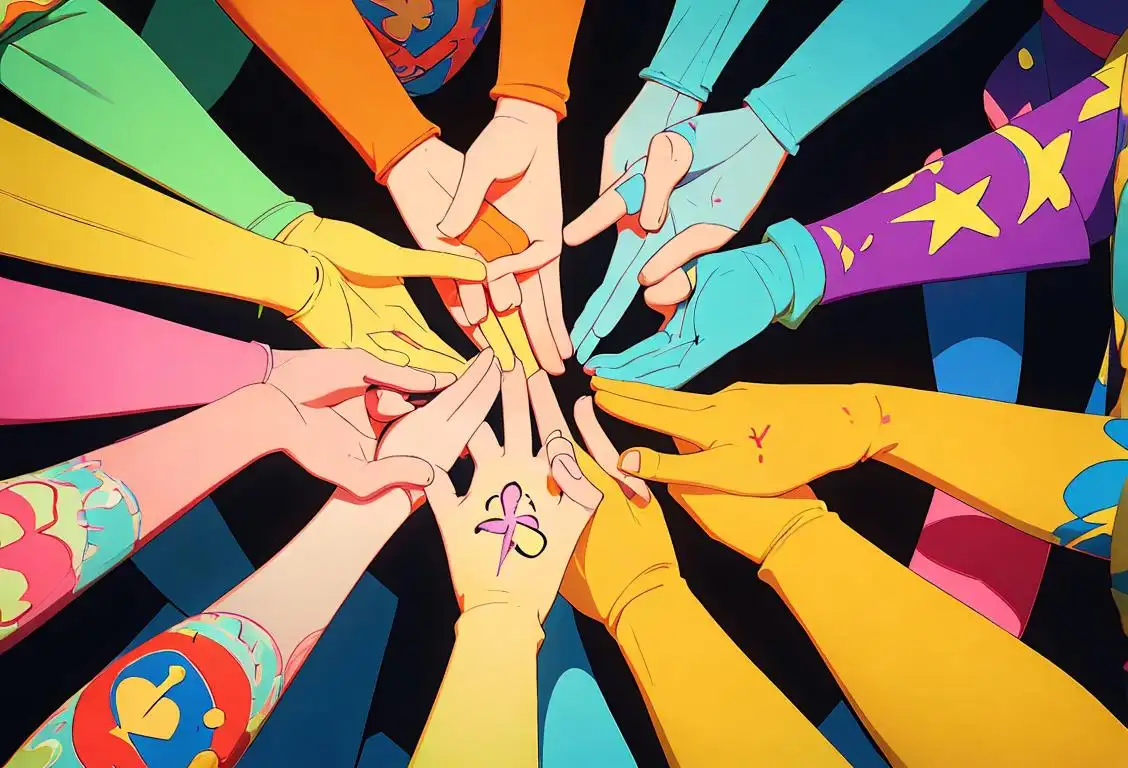National Left Handlers Day

Hey there, fellow lefties! Get ready to celebrate the incredible uniqueness of being a left-hander on National Left Handlers Day! It's time to give a well-deserved shout-out to all the lefties out there who navigate a right-handed world with style and grace.
When is Left Handlers Day?
It's national left handlers day on the 13th August.
The Surprising History of National Left Handlers Day
On this delightful day, we gather to honor the incredible left-handed individuals who have graced us throughout history. National Left Handlers Day originated as an Internet phenomenon, shining a light on the incredible talents of left-handed people. It gained popularity through a viral campaign on social media back in 2015.
Now, you might be wondering why lefties need a special day. Well, historically, left-handedness has often been viewed with suspicion and superstition. In many cultures, being left-handed was associated with evil or even witchcraft. Thankfully, we've come a long way since then, and National Left Handlers Day is a way to celebrate and embrace the unique strengths and talents that left-handers bring to the world.
Left-handers have made significant contributions to various fields, including sports, arts, and sciences. From famous left-handed artists like Leonardo da Vinci to legendary southpaws in sports like Babe Ruth and Rafael Nadal, left-handers have left their mark on history.
Fun Ways to Celebrate National Left Handlers Day
If you're a left-hander or have a left-handed friend or loved one, there are countless ways to make this day extra special. Here are a few ideas to get you started:
- Host a Left-Handed Olympics: Challenge your fellow lefties to a series of left-hand dominant activities, like writing, throwing, or even using scissors! Get those left-handed skills in full swing.
- Take a Left-Handed Test Drive: Visit a specialty store that caters to left-handers and try out some left-handed tools and gadgets. It's like stepping into a world designed just for you.
- Spread Left-Handed Awareness: Share interesting facts and experiences about left-handedness on social media using the hashtag #LeftHandlersDay. Let's educate the world about the awesomeness of being a leftie!
Did You Know?
Did you know that approximately 10% of the world's population is left-handed? That means there are over 700 million left-handers worldwide!
History behind the term 'Left Handlers'
1913
The emergence of the term 'left handlers'
The term 'left handlers' originated in 1913, referring to individuals who predominantly used their left hand for tasks and activities. It was used to describe left-handed individuals who exhibited a natural preference for their left hand in writing, eating, and various other everyday tasks.
1700
Emergence of the Term 'Left Handler'
In the early 18th century, the term 'left handler' started to gain popularity. This term was used to describe individuals who primarily used their left hand for various activities. It was particularly prominent in reference to individuals who favored their left hand for writing or other manual tasks. At this time, being left-handed was often seen as unusual or even suspicious, as the majority of the population was right-handed.
15th century
Introduction of the term 'left handlers'
The term 'left handlers' first came into existence during the 15th century. It referred to individuals who predominantly used their left hand for everyday tasks, such as writing, eating, and crafting. This term gained significance as it marked a deviation from the norm, as most people were right-handed. Left-handedness was seen as unusual and often associated with being different or even evil.
3000 BCE
Early Evidence of Left Handedness
Archaeological evidence suggests that left-handedness has been present in human populations since ancient times. Cave paintings from as early as 3000 BCE depict left-handed individuals in various activities, indicating that left-handedness has existed for millennia.
448 AD
The Left-Handed Stigma
In 448 AD, the term 'left handlers' first emerged as a derogatory label associated with the left-handed individuals. Back in ancient times, left-handedness was often seen as taboo and associated with evil or witchcraft in many cultures. The Latin word for left is 'sinister,' which eventually gained negative connotations, further fueling the stigma towards left-handed individuals.
1860
Negative Connotations and Stereotypes
During the 19th century, the term 'left handler' began to carry negative connotations. Left-handed individuals were often associated with clumsiness, evil, and even witchcraft. Some cultures held strong superstitions surrounding left-handedness, which further contributed to the stigmatization of left handlers. These stereotypes persisted for many years and influenced societal attitudes towards left-handed individuals.
1700 BCE
Symbolism in Ancient Egypt
In Ancient Egypt, the left hand was associated with femininity, passivity, and intuition. The goddess Isis, often depicted as a left-handed woman, represented magical powers and creativity. This association elevated the significance of left-handedness in Egyptian culture.
1692
The negative connotation of left-handedness
In 1692, during the Salem Witch Trials, left-handedness was condemned and linked to witchcraft and the devil. The superstitions and prejudices surrounding left-handedness persisted for centuries, contributing to the stigmatization of left-handed individuals.
1970
Recognition of left-handedness as natural
During the 1970s, the term 'left handlers' gained more prominence as society started recognizing left-handedness as a natural and innate trait rather than an oddity or a mark of clumsiness. This recognition helped dispel negative stereotypes associated with left-handedness and fostered a more inclusive attitude towards left-handed individuals.
1596
The Influence of Leonardo da Vinci
In 1596, the renowned artist and inventor Leonardo da Vinci left behind numerous sketches and writings that showcased his left-handedness. His fame and contributions played a significant role in challenging the negative perception of left-handers. Despite his success, left-handedness remained uncommon and often faced discrimination well into later centuries.
44 BCE
Negative Connotations in Roman Times
During the time of the Roman Empire, left-handedness took on negative connotations. The Latin word for left, 'sinister,' began to acquire associations with evil, deception, and bad luck. These negative connotations persisted for centuries.
1976
International Left-Handers Day established
In 1976, the first International Left-Handers Day was established as a celebration of left-handedness and an opportunity to raise awareness about the challenges faced by left-handers in a predominantly right-handed world. This day aims to promote equality and inclusivity for left-handed individuals and recognize their unique abilities.
1970
Recognition and Acceptance
In the 20th century, attitudes towards left handlers started to shift. The term 'left handler' gradually gave way to more neutral and positive terms such as 'left-handed' or 'southpaw.' With increased awareness and understanding, left-handed individuals began to be recognized for their unique abilities and contributions. Many famous left-handed individuals emerged as successful artists, athletes, and intellectuals, challenging the negative stereotypes associated with left-handedness.
19th Century
The Industrial Revolution and Ignoring Left-Handers
During the Industrial Revolution in the 19th century, the rapid innovation and increased use of machinery led to a push for standardization. The majority of tools and equipment were designed for right-handed individuals, making it difficult for left-handers to navigate the industrial landscape. Rather than accommodating left-handers, society further marginalized them by simply ignoring their needs.
19th century
Shift towards acceptance and acknowledgment
As societal attitudes started to change in the 19th century, left-handedness began to be viewed less negatively. The scientific community started studying left-handedness, and researchers like Sir Francis Galton explored the origins and characteristics of left-handedness, debunking the earlier associations with evil.
1992
Left-handedness studied scientifically
In 1992, the scientific community began conducting extensive research on left-handedness, exploring its genetic, neurological, and cognitive aspects. These studies contributed to a greater understanding of left-handedness and revealed some interesting correlations between left-handedness and specific traits, such as increased creativity and a slightly higher likelihood of certain health conditions.
20th century
Championing left-handedness
In the 20th century, organizations dedicated to supporting and celebrating left-handed individuals emerged, such as the Left-Handers Club, established in 1990. These groups aimed to raise awareness of the challenges faced by left-handers in a right-handed world and promote understanding and acceptance of their unique abilities and perspectives.
20th Century
The Left-Handers Club and Promoting Awareness
In the 20th century, specifically in 1962, the Left-Handers Club was established in the United Kingdom. This organization aimed to raise awareness about the challenges faced by left-handers and promote a more inclusive society. Through education and advocacy, the Left-Handers Club helped dispel myths and stereotypes associated with left-handedness, gradually fostering a more accepting environment.
18th Century
Discrimination and Superstitions
In the 18th century, left-handers faced discrimination and superstitions throughout Europe. Left-handedness was often considered a sign of evil or witchcraft, leading to social stigmatization and prejudice against left-handers. Many cultural beliefs and customs were centered around favoring right-handedness over left-handedness.
1976
International Left-Handers Day
To celebrate and raise awareness about the experiences of left-handed individuals, International Left-Handers Day was established in 1976. This annual observance, held on August 13th, aims to promote understanding and appreciation for left handlers' distinctive style of doing things. It provides a platform for discussions on inclusive practices and highlights the importance of embracing diversity in society.
19th Century
Scientific Interest and Research
In the 19th century, scientific interest in left-handedness began to emerge. Researchers started studying the brain hemispheres' dominance and its relation to handedness, leading to a better understanding of left-handed individuals' unique cognitive abilities.
1976
International Left-Handers Day
International Left-Handers Day, observed annually on August 13th, was established in 1976 by Dean R. Campbell. This day serves as a global celebration of left-handedness and aims to increase public awareness about the advantages and disadvantages of being left-handed. It also encourages the development of tools and products designed for left-handed individuals.
Present
Continued recognition and support
Today, the term 'left handlers' continues to be used in various contexts to acknowledge and support left-handed individuals. With more awareness and understanding, left-handers are progressively accommodated in schools, workplaces, and daily life. Celebrations on International Left-Handers Day provide an opportunity to appreciate the contributions of 'left handlers' to our society.
1976
International Left-Handers Day
In 1976, the founder of the Left-Handers Club, Dean R. Campbell, created International Left-Handers Day. Celebrated annually on August 13th, this day serves to both raise awareness about the unique needs of left-handers and celebrate their contributions to society. It has become an important cultural touchpoint that highlights diversity and promotes inclusivity.
20th Century
Modern Acceptance and Acknowledgment
During the 20th century, societal attitudes towards left-handedness shifted positively. International Left-handers Day, celebrated on August 13th, was established in 1976 to raise awareness and celebrate the uniqueness of left-handers. Left-handed individuals now have various tools and resources that cater to their needs.
Did you know?
Did you know that approximately 10% of the world's population is left-handed? That means there are over 700 million left-handers worldwide!Tagged
awareness fun loved onesFirst identified
13th August 2015Most mentioned on
13th August 2015Total mentions
87Other days
Compliment Day
Cheese Pizza Day
Pumpkin Day
Medal Of Honor Day
Guac Day
Foundation Day
Suicide Prevention Day
Memorial Day
Cancer Survivors Day
Bacon Day









